Click here to listen.
Listen to me talk about my Oscar predictions on Movie Geeks United
Podcast: O’Steen again appears on Movie Geeks United
Since her original podcast Bobbie O’Steen has made two additional appearances on Movie Geeks United! On her second visit, she spoke some more about ‘The Invisible Cut’ and EditFest NY and EditFest LA. That show included Michael Rooker and was podcast on September 27, 2009. Listen to the podcast.
O’Steen is also proud to be a part of a tribute to Roman Polanski’s extraordinary life and career, which was recorded before his arrest and originally broadcast on October 4, 2009. Listen now.
On an upcoming episode of Movie Geeks United! O’Steen will be discussing this year’s Oscar nominees for Best Editing.
Moderating a Panel at EditFest LA
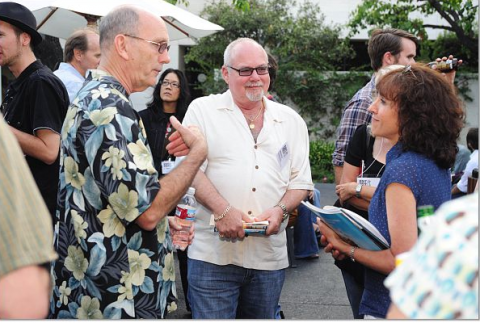
Talking shop with editor Joel Cox and A.C.E. President Randy Roberts
Two months after moderating a panel at EditFest NY, I did the same for EditFest LA, which took place on the Universal Studios lot.
Randy Roberts, the president of A.C.E. (American Cinema Editors), was once again a genial host giving the audience – mostly composed of aspiring editors – sound career advice. Example being: “Leave your ego at the door.”
The topic of discussion for my panel was again “Small Screen, Big Picture: Editing Television” and my panelists were all really interesting and different, both in personality and work experience.
Malcolm Jamieson, who was originally an artist, was very passionate when he talked about the art of editing, and in the clip he showed from Mad Men he explained how he achieved an important and poignant moment between two characters. David Rogers showed a hilarious clip from The Office, which showed how he was able to sequence – with dizzying swish pans and multiple points of view – the best performances and reactions. Karen Stern showed a clip from Law & Order: SVU with Robin Williams, where she was able to create and sustain the riveting intensity of the scene. Chris Willingham showed a clip from 24 and spoke about the challenges of editing in real time, and not being able to use cutaways and other time-jumping devices that editors usually rely upon. His wife, Lynne Willingham, showed a clip from Breaking Bad (for which she just won her second Emmy) and spoke compassionately about how difficult it is for some of the directors on this series – who are often from indie film backgrounds – to adjust to working in a producer-controlled medium.
I had great conversations with two very different and fascinating feature film editors as well. Brent White (who edits the movies Judd Apatow directs and the two he produced with Adam McKay directing) comes from a background one might not expect – he’s a Mormon from Utah. On the other hand it’s not really surprising that this family man with a positive personality would be the right choice. After all, there is a warm, relationship-oriented sensibility underlying the outrageous bad boy/dark humor in Apatow’s work. These movies shoot a ton of footage and much of it is improvised, so his editor also has to have a lot of patience and insight to find the gold in them thar hills. Example: the high-point scene in McKay’s Talladega Nights was written in the screenplay as just a dinner table scene with product placement.’ They let the cameras roll for two days straight!
Joel Cox is Clint Eastwood’s editor and has the same macho, no-nonsense strength about him as his director. He told me that my husband Sam O’Steen, who he had known when they were both apprentices at Warner Brothers, influenced him in two ways. He was inspired by Sam’s resolve to wait for that break into feature films no matter how long it took. (It took Sam 18 years: 10 years in Warner’s print shop and 8 years assisting, finally becoming an editor on Youngblood Hawke.) Sam also never looked at anything he cut until he ran it for the director. The lack of second guessing, is very compatible with Eastwood’s style of shooting, since he rarely shoots multiple takes and is very clear about what he wants before he starts filming.
All told it was an inspiring weekend. And editors are funny, they are not by nature talkers, and often seem mortified at the idea of getting up and speaking. But once they get started – boy, can they talk!
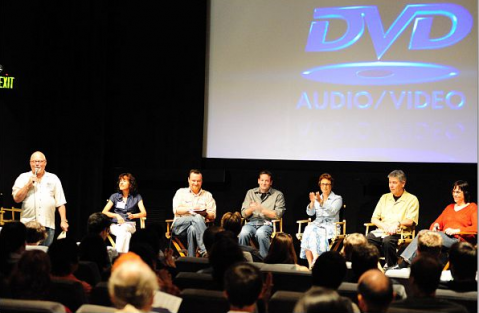
My panel: Malcolm Jamieson, David Rogers, Karen Stern, Chris Willingham and Lynne Willingham
Upcoming EditFest appearances
- When: Saturday, August 7.
- Where: Universal Studios
- Subject: Editing Television

O’Steen will act as moderator for panel discussion at EditFest Los Angeles. The second of its kind: a weekend in Los Angeles celebrating the art of film editing.
- O’Steen will act as moderator for panel discussion at EditFest New York. The first of its kind: a weekend in New York celebrating the art of film editing.
- When: Saturday, June 13. 2:30-4:00PM
- Where: The Director’s Guild Guild of America, 110 W. 57th Street, New York
- Subject: Small Screen, Big Picture: Editing Television
- Panelists: Michael Berenbaum (Sex and the City, Nurse Jackie), Ken Eluto (30 Rock, Oz), Alex Hall (The Unusuals, The Wire), Meg Reticker (30 Rock, Big Love), Kate Sanford (The Wire, Kings)

EditFest New York
Moderating a panel at EditFest New York
EditFest LA was launched with great success last year by ACE (American Cinema Editors) – the honorary guild for editors – and this year they decided to have EditFest NY on June 12th and 13th at the Directors Guild Theater. This was the first event of its kind: two incredible days of panel discussions where many of the most respected and well-known editors analyzed their work and careers for an eager audience of up-and-coming filmmakers.
I moderated a panel called “Small Screen, Big Picture: Editing Television” and my panelists included Michael Berenbaum (Sex and the City, Nurse Jackie), Ken Eluto (30 Rock, Oz), Alex Hall (The Wire, The Unusuals), Meg Reticker (30 Rock, Big Love) and Kate Sanford (The Wire, Kings)
What I found unique about ‘my’ New Yorkers, having worked and lived among editors from both coasts, was a true intimacy among them, probably because New York has a smaller industry and the geography of the city is more compact. And because there are fewer jobs, New York editors end up not being pigeon-holed; at any point in time they may be working on a documentary, an indie feature, or a TV show. Considering how small the job pool is and how often they worked on the same TV series, you’d think they would be especially competitive but I found just the opposite. They were very supportive of one another.
My panelists started off by telling amusing and insightful stories about how they got their breaks; they also talked about the difference between cutting comedy and drama (there really isn’t any), the difference in whom they have to answer to (in television it’s the producer, in features it’s the director). When I asked them what they wish someone had told them when they were starting out, the truth is that, although talent is necessary, passion – and compassion – are essential ingredients for success.
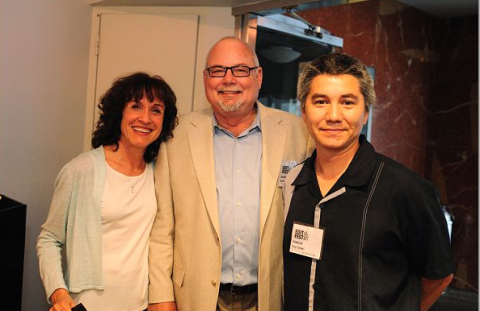
With ACE president Randy Roberts and panelist/editor Troy Takaki.
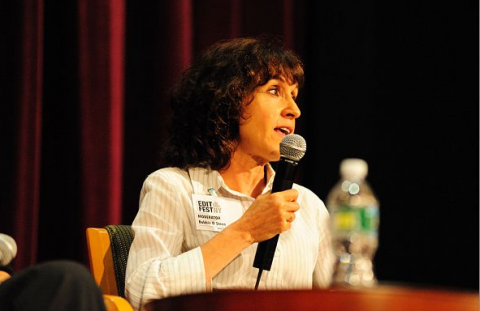
Moderating the panel
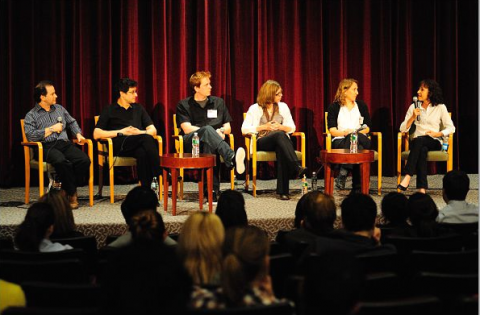
My panel: Michael Berenbaum, Ken Eluto, Alex Hall, Meg Reticker and Kate Sanford
Photos by Tilt Photo.
Hidden Magic Revealed
Editors Guild Magazine
March-April 2009
![]() Married to legendary film editor Sam O’Steen for 23 years, Bobbie O’Steen compiled the many discussions and interviews with her husband about editing into a memoir entitled Cut to the Chase that was published in 2002. Reviewed in these pages in the MAY-JUN 06 issue (and still online at the www.editorsguild.com), Cut to the Chase is a primary book on the craft of editing featuring insights from the man who edited films such as Who’s Afraid of Virginia Woolf? (1966), The Graduate (1967), Cool Hand Luke (1967), Rosemary’s Baby (1968) and Chinatown (1974).
Married to legendary film editor Sam O’Steen for 23 years, Bobbie O’Steen compiled the many discussions and interviews with her husband about editing into a memoir entitled Cut to the Chase that was published in 2002. Reviewed in these pages in the MAY-JUN 06 issue (and still online at the www.editorsguild.com), Cut to the Chase is a primary book on the craft of editing featuring insights from the man who edited films such as Who’s Afraid of Virginia Woolf? (1966), The Graduate (1967), Cool Hand Luke (1967), Rosemary’s Baby (1968) and Chinatown (1974).
O’Steen’s new work, The Invisible Cut: How Editors Make Movie Magic (due on shelves in March), will stand as a deft introduction to the “invisible art†of editing and would prove highly useful as a textbook. Her language is direct and the complex craft of editing is clearly explained. Comparing the work of the motion picture editor to that of the stage magician, O’Steen begins with fundamentals and then moves to examples of classic films to illustrate the hidden magic of the editor. Very simply put, the editor decides what is seen on the screen and how long it will be seen. But in this obvious task is great subtlety.
Modern Romance
This scene from Modern Romance – where the film editor (Albert Brooks) is cutting a cheesy sci fi flick – is not only painfully funny but realistically captures what can happen in the cutting room. First we see that Bruno Kirby, who plays Albert Brooks’ assistant, is eager to get credit for a cut he made, which Brooks complements him on – what a nice boss! Then the director (played by the real-life director James Brooks) comes in with a stupid idea, a sound effect that doesn’t matter, and although the editor initially fights it, he gives in to the director’s incessant demand. Worse still, we had just seen the editor make a change that really helps the movie. He took out a line an actor says to avoid revealing a crucial piece of information too early on. When he shows this change to the director, he’s not happy because he likes the next actor’s (George Kennedy’s) reaction to that line. The editor explains that keeping the first actor’s line in, tips the audience off, but it’s more important to the director to keep Kennedy’s precious line. He’s ignoring a very important piece of advice I give in The Invisible Cut: “Movie first, scene second, moment third.” That should be the order of importance whenever an editing decision is made. The director, in this scene, is holding onto a moment he likes rather than seeing the overall movie and how important it is to set up mystery and suspense in the story. When the editor caves in for the second time to the director’s misguided judgment, we experience the frustrating compromises that are often made in the cutting room.
This is also the only movie that I know of where a film editor is the romantic lead. Does anyone know of any other? I would like to know!
What Whoopie and I think About Film Editors and the movie Duplicity
Whoopie Goldberg spoke a moviemaking truth on the NBC show The View. She said, “Did it occur to anyone that the movie maybe wasn’t that interesting? … A good script and a GREAT EDITOR — and you know how I feel about editors…may bring Julia Roberts where she needs to be!” Watch the clip:
The movie Whoopie Goldberg is referring to is Duplicity and she is right, a good script and a great editor are essential. The editor of Duplicity, John Gilroy, actually did a terrific job. He chose shots that make Julia Roberts look gorgeous, play up her charm and capture her charismatic pairing with the smoldering Clive Owen. The storyline and chronology of this caper is intricate and complicated, and the editor also manages to keep the audience involved and on track.
A subtler but equally daunting challenge is the development of the romance between Roberts and Owen, both former government spies and masters of deception, who have now decided to conspire to make a killing in the corporate world. Editor Gilroy has to keep audience in a suspended state, without giving away which one of them might be betraying the other. At the beginning, Owen is the one who gets duped by Roberts and after that the editor will sometimes subtly shift to Owen’s point of view, making him a bit of an underdog. There are also very carefully planted moments where the audience is given just a little more information than Owen’s character. At one point, for example, when Owen is following Roberts, the audience is allowed to see a knowing look from her that reveals she is secretly aware of him. But there are also surprising and satisfying moments, when Owen shows his machismo and upper hand.
As Roberts and Owen do their insider/double-agent work between the two corporate rivals the editor uses many flashbacks to slowly let the audience in on more and more information, not only about the plot but about Owen’s and Robert’s relationship. In the more intimate scenes between these two romantic leads, the choice of shots is always right, particularly when the editor decides to cut in close and show a glimmer of each of their character’s vulnerability.
The filmmakers occasionally use multiple screens that show simultaneous action, which actually doesn’t reveal much information. It’s a self-conscious device that, if anything, disrupts the flow just a bit. Maybe it also stands out, because the style shooting and editing is not flashy at all; it’s very streamlined. Along with his editor, writer/director Tony Gilroy also achieves the perfect blend of tension-packed intrigue and comedy romance and keeps all the cards up in the air until they ultimately fall in a surprising way. Maybe a genetic link makes the editor and writer/director especially in sync and creates an even better editor/director “marriage” – which I talk about in my book? After all, John Gilroy and Tony Gilroy are brothers!
And yet, when all is said and done, why is the movie not a hit? Maybe the story is too clever for its own good, or more importantly, maybe the endgame is ultimately somewhat hollow. That is, do we really care which pharmaceutical giant gets the patent to a special lotion? Julia Roberts has certainly covered caper movie territory before in the Oceans 11 movies. And the fact that the leads are by nature duplicitous makes the romance intriguing, but a bit chilly as well. The audience might want more genuine humanity and warmth from their screen sweetheart, Julia Roberts, and a more satisfying stake in her story – besides corporate shenanigans.
Whoopie is right, a great editor is crucial for a successful movie, but he or she can only be as good as the material. Contrary to popular belief, miracles are not made in the cutting room.
O’Steen interviewed on Movie Geeks United podcast
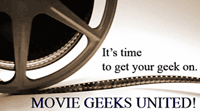
Bobbie O’Steen discusses the art of editing and her new book
‘The Invisible Cut’… Listen to the podcast.




